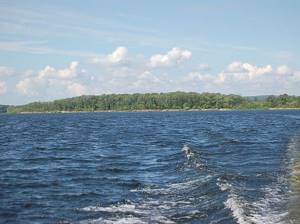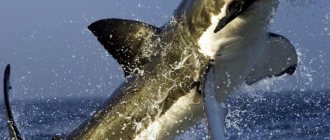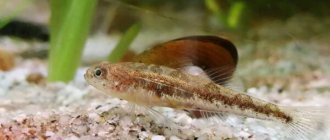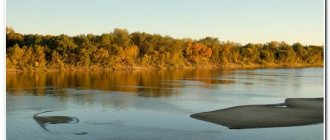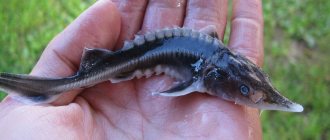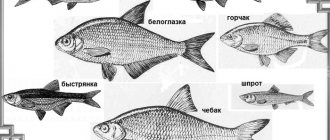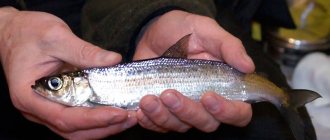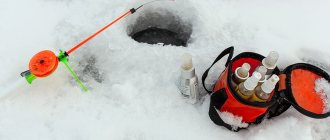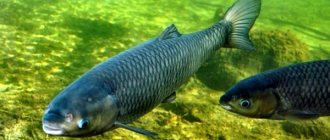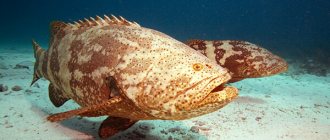What happens?
This term has been known for a long time. Following their path through the rivers, the sturgeon families - beluga and sturgeon - occupied deep holes - river beds for the winter, falling into semi-hibernation.
People were aware of the location of these pits. In winter, in these places, the deepest on the river, they made ice holes and pulled out sleepy fish with hooks. That’s when the name “red fish” came from – not from the color of its meat, but from its high value.
In addition, another fish such as bream also led people to think about the presence and inhabitants of the pits. This type of fish tends to gather in huge quantities in one place for the winter. And the massive catch of it using seines began in full swing. After such harvesting, the bream population in one reservoir declined sharply and recovered within several years.
However, when there was a threat of a decline in the sturgeon population, fishermen’s access to these pits became limited. It was necessary to create conditions for fish farming to exceed its catch.
Types of fishing in Russia
GPS navigator for fishing
Choosing a place for winter fishing. Where to drill holes?
In modern times, this concept has changed a little. Large numbers of fish gather in different places near the bottom, and not in deep holes.
Pisces do not just fall asleep in one position, as was previously thought, but make internal movements in different directions through the center. Moreover, even though the fish feed without much activity, schools from time to time leave their wintering places, where there is nothing left to feed on.
In especially deep lakes, their inhabitants avoid large holes at the very bottom, since a lot of carbon dioxide accumulates there. If reservoirs have strong currents, then the fish tries to get as far and deep as possible. And so he looks for quieter areas. The fact is that the fish during this period does not have much strength to resist the current. But although it should be weak, the water should not be stagnant. Lying flocks need oxygen, which is supplied by water.
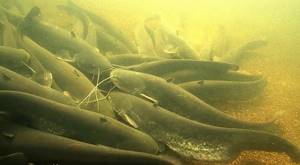
As you know, catfish do not live in schools. But in winter they form groups and hibernate. This is the seasonal time when the catfish's main food source, the frog, also enters suspended animation. But there is an opinion that catfish from northern latitudes experience digestive problems at low temperatures.
But catfish choose not just deep holes for wintering. They must have favorable conditions, such as running water and currents. In winter, these fish feed little. In addition to frogs, they hunt large fish such as carp. The situation begins to change when catfish and carp spend the winter in neighboring depressions and often compete for elite places. There are areas where these fish live together. There is no special peace here. There is a “hot” dispute for a place in the center of the pit. The decisive factor is the number of species. It happens that carp drive away catfish.
It is easier to catch carp in winter than catfish. From time to time he leaves the pit to look for mollusk larvae. At this moment, the fisherman may have the right moment. A carp that has left the pit in search of food and encounters bait can swallow it. Fishermen note that the ice hole must be of suitable size.
The sense organs of fish are better developed than those of humans. Compared to our five, fish have 12 senses. Therefore, they quickly notice the bait, and in addition, choose the right streams. All currents, changing, will be noticed by the fish. For them, the water column is not just a continuous medium, but a structured system. The fish is not just looking for deep or shallow places - it will prefer a shallow place, but with a strong current.
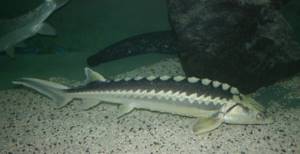
Experienced fishermen themselves are already beginning to understand these subtleties and understand how the fish will behave in a given place.
How we caught catfish in late autumn as children

In autumn, catfish continue to feed on quiet, windless and warm days. Cold autumn rain does not contribute to the bite.
For successful fishing, it is necessary to correctly identify a promising section of the river.
It’s good if you know the “wintering” pits in which catfish, along with carp and other large fish, wait out the winter.
But, firstly, fishing in such places is considered poaching, and secondly, when the catfish falls into such a hole, it stops actively feeding.
Knowing the location of the wintering pit is necessary in order to guard the catfish on the approaches to this pit.
In rivers, catfish rise into holes against the current.
Therefore, there is no point in looking for them on deep rifts above holes, as is done in the summer.
The best places for hunting are sections of the river between coastal holes with a quiet, or even better, reverse flow, and the river bed. The pits located in numerous Volga “prorans”, “Volozhkas” and “prorovs” are very good.
Catfish rise up against the flow of the river towards the “winter apartment”, and at the approaches hunters for large and strong fish are already waiting for them.
If there are no holes nearby, then you can choose the lower edge of the channel for fishing, but only in those places where the channel turns sharply to the side. Such places are determined by the break in the high bank, and by the increase in depth, and by the weakening of the strength of the current. It’s good if you find a deep place with a reverse flow.
If the flow over a large section of the river is smooth, then you need to look for a hole in the riverbed and fish directly in it.
Read the material “Fighting the “mustachioed bonus””
But now the fishing spot has been chosen and I want to see the bite quickly. Don’t rush, catfishing itself takes place in a rhythm of waiting, imposingness and half-asleep.
Think about your own safety first. For example, what will you do if you are fishing from a double “inflatable” and you come across a catfish weighing at least 50 kg.
Now most fishermen, among those who go to Akhtuba every year, will say that you can’t fish like that. You need to either rent a boat or fish from the shore using gear designed for tuna fishing. Don’t listen to such “experts”; they started catching catfish after they were shown how to do it.
In order to protect yourself while fighting strong fish, there is a much simpler and more reliable method, described by L.P. Sabaneev. Leonid Pavlovich described catching large catfish using “barrels” and “bubbles”. However, he described these tackles as a type of girders, or rather “postavukhs”.
When I was in high school, my friends and I caught catfish, as all Samara fishermen did. The film “Jaws” had not yet been created, but we read Sabaneev carefully and listened to our senior comrades.
Read the material “Tips from the last century for hunting wild geese”
So, the essence of the fishing method is that the end of the tackle is tied not to a reel or spinning rod, but to a tree when fishing from the shore or to an inflated chamber from a heavy-duty vehicle if fishing from a boat. In those days, KAMAZ was just being built and we took cameras from MAZ.
The basis of the tackle was either a thick fishing line with a diameter of 1.5-2 mm or a braided (but not twisted) nylon cord. The length of the cord was 15 m greater than the maximum depth along the Volga riverbed, i.e. about 45-50 m.
We tied a hook of size 20-25 (according to the domestic classification) to the cord; tuna hooks produced by the Kolyubyakinsky Needle Factory were good. Before tying the hook, it was necessary to solder the ring so that at the junction of the eye and the fore-end there was not only no gap, but also no burrs.
At a distance of half a meter or more, a sinker was tied to the cord on a leash. The equipment resembled a modern “diverter leash”. The length of the leash with a hook depends only on the strength of the current; the stronger the current, the longer the leash.
When fishing from the shore, the tackle was brought from the shore by boat. As a sinker, we used a light anchor with a mustache made of reinforcement with a diameter of 6-8 mm, so that when hooked, they could be straightened. The sinker should hold the entire tackle in place, as if the tackle were being used as a “posture”.
If you were fishing from a boat by floating, then the load was used in a compact shape so that it was possible to tap the bottom.
Read the material “And in Kiev there is steel!”
Live bait was more often used as bait. It’s simply impossible to find frogs in October, and hooking a crow or sparrow is both troublesome and pathetic.
As live bait, preference should be given to asp, chub or ide. The meat of these fish is dense and holds well on the hook. If the goal of the hunt is a large catfish, then you need to take larger live bait, for example, an asp weighing a kilogram.
To hold large live bait on the tackle, special equipment is used; the essence of its design is that above the hook, which is tied at the end of the fishing line, several more hooks of the same size are strung onto the fishing line or cord. The top hook is hooked to the head of the bait, and all the others are hooked under the base of the fins. Regardless of how the catfish grabs the prey, across the body, or by the head, at least one of the hooks will fulfill the “high mission” assigned to it.
Fishing time in the fall does not play such a significant role. In the fall, you are equally likely to catch catfish both in the morning and in the afternoon. However, it is still preferable to fish on a quiet morning from 6 to 11 o’clock. At this time of day the weather is usually more stable and quiet.
Fishing tactics can vary and depend mainly on how well the angler knows the location of the fish. If the location of the catfish was known exactly, and this was determined by previous bites, then it was possible to anchor the tackle using a heavy sinker in a place that was detected by coastal landmarks (there were no echo sounders then).
From fishing practice it was known that there is no point in installing more than 4-5 gear. Experienced fishermen do not recommend placing gear further than 10 from each other.
The colder the water becomes, the more rapidly the efficiency of fishing with supplied gear decreases. This is explained by the fact that the catfish becomes less and less active and often throws the bait as soon as it feels resistance from the gear.
Then we proceeded as follows. We swam a boat upstream, lowered a relatively light equipment to the bottom and drifted the boat with the current.
You need to hit the bottom with a sinker every 2-3 seconds so that the bait drags along the bottom. At the same time, the cord is held in the hand, and when they feel resistance or a hook, the baits release about 5 m of the cord and, after the current picks up the slack, they hook. So they float along the area chosen for fishing and return back, but move a little to the side.
Read the material “Why are we going into the taiga?”
If, after the next hook, the object of the hunt begins to resist at the other end of the tackle, you can try to pull it towards the boat. If the catfish is large and does not want to rise, the cord and the balloon attached to it are thrown into the water. They take out the second tackle and resume fishing. Every half hour they return to the catfish and, tightening the tackle, force it to move, resist and lose strength.
In conclusion, I can say that in this way it was possible to catch two catfish weighing 50-70 kg each day and a little more “lighter” ones.
|
| The Volga is lower than Samara. Photo: Andrey Yanshevsky. |
Several years ago, while in Samara, I sailed with the fishermen who invited me on a boat with good echo sounders along the entire multi-kilometer section of the Volga, on which at different times of the year everyone successfully caught bream, asp, catfish, pike perch, saberfish, Caspian herring, pike, chub and perch with roach.
The picture on echo sounders is like in a large swimming pool - a flat bottom, above which there is nothing and no one except water.
Andrey Yanshevsky September 26, 2021 at 05:54
Seasonal exit from pits
When spring comes, the release of fish depends on how warm the air is. For many fish, the appearance of melt water is a sign of warming, and it is already possible to leave the pit. Melt water differs in composition from river water. Flowing from the banks into the reservoir, it is saturated with nutrients from the soil and oxygen. The general awakening is also changing the behavior of fish. In the spring, the fish strives to intensively search for food in order to gain strength for spawning. In summer, she does not visit deep holes at all, because the main food lives in shallow water.
Therefore, wintering pits are a necessary “room” for fish for the winter.
What does the law say?
Unfortunately, the law prohibits fishing in wintering areas. However, with some reservations.
Firstly, the ban on fishing in wintering pits comes into force on November 1, and will last until April 30.
The fine for violating this article of the law ranges from 2,000 rubles to 5,000 rubles.
When caught in a wintering pit for the first time, the inspector will most likely issue a minimum fine, that is, 2,000 rubles. If you violate it again, you will have to fork out a large amount - five thousand.
If this article of the law is repeatedly violated, the fisherman will face not administrative, but criminal punishment, with all the ensuing consequences, that is, detention.
Fisheries inspectors keep a particularly close eye on fishermen. They know all the locations of wintering pits.
And during planned raids, these areas are inspected first.
And now the most interesting thing is how you can fish in wintering pits so as not to get fined.
Pit structure
There are several sections in the river pit.
Predyamye
Plot of 2...3 m; located before the bottom begins to decline. The autumn bite there is not active, therefore, if you decide to fish here, you should not spend money on bait. It will still be carried away by the current and spread completely randomly and stupidly throughout the pit.
A decent fish in a hole, as a rule, does not react to such bait - it can only attract small things.
The place is interesting because small fish often come here, often followed by pike and, less often, fanged pike perch.
Dump (entrance) into the pit
The area is the most interesting in terms of fishing, because here in almost all the holes in the reservoirs a lot of fish and different species gather. It can have different steepness.
Steeper entrances are a favorite place for fish in the fall. Different fish on them are distributed along different horizons: for example, for large pike perch, catfish, bream, the lower, deepest part of the entrance is more comfortable; the upper part, almost at the very foot of the river, is inhabited by small pike perch, chub, ide, large roach, perch and pike.
The most catchy place on dumps is their middle; Only when the weather outside is unstable and there is prolonged cold, preference should be given to lower horizons of the site.
Often on dumps there are short, 1...1.5 m, flat areas called tables. They are always inhabited by large fish - usually a small school of bream or a single predator.
The pit itself
This area has the maximum depth. The fish bite is normal, similar to what happens in the foreland area, with the exception of bottom-dwelling fish, for example, catfish, which are best hunted in such a place.
If the bottom is flat and free from snags, fishing in a pit is unpromising (with the exception of a wintering pit, about which later. However, by the fall, white fish can gather in it in preparation for winter in large quantities. Therefore, if the predator’s bite is very bad, you can use a lightweight donk, successfully caught with underwear.
Snag holes for fishing are more interesting. Although in this case one would need to know the location of the writhing under water, which is difficult and sometimes costly to do due to the possible loss (and more than one) of gear.
At the bottom of some holes there may be irregularities, for example, banks, which are, in fact, underwater shallows. This type of hole is the most valuable for fishing, as it contains large fish and predators.
The beginning of the bank (downstream) is usually without fish. The best place for fishing is the end of the bank, or rather the drop - an area with a sharp increase in depth to the bottom of the hole. In such a place there is a high probability of catching trophy pike.
The sides of the cans also bring a catch, but, inexplicably, one of the sides always works better.
At the bottom of the pits there are sometimes small depressions that also look like pits. They are significantly inferior in catchability to banks. In autumn, sometimes there can be a lot of fish in them, especially white bream and silver bream.
Exit from the pit
An area where relief occurs. It is considered catchable, although in terms of fish activity it is inferior to the entrance to the pit. In addition, if it is steep, then fishing can turn into a complete strain on the nerves.
Post-pit
An area 20...40 m behind the pit (downstream); smooth. It is promising for fishing, especially from spring to early autumn. Usually good for asp and pike. If the weather is good in late autumn, you can also hope for a decent bite.
Pit shape
All pits are of two types:
- longitudinal - in plan they are similar to an ellipse elongated along the direction of the flow;
- rounded – close in outline to a circle; those of them with steep slopes at the edges are called whirlpools.
Wintering pits and predators under the ice
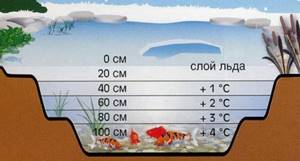
Winter cold snap is the time when the increase in aquatic vegetation and plankton stops. Fish, whose food supply is becoming scarce, reduce their vital activity, gather in schools, and look for suitable places for wintering. Individuals of the same age and size gather in wintering pits. This makes it easier for them to endure the cold, clustering tightly in flocks. Mucus abundantly secreted on the surface of the scales helps to resist the cold and minimize energy costs. Most likely, it is this that scares away predators; the population of fish waiting out the cold remains untouched throughout the winter.
Interesting: Pisces
